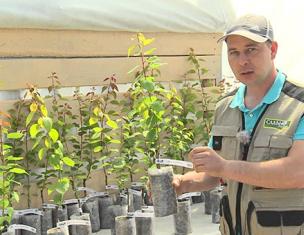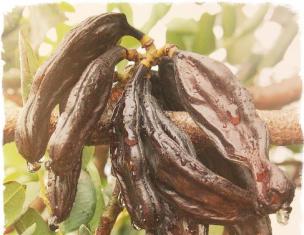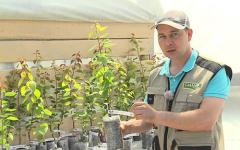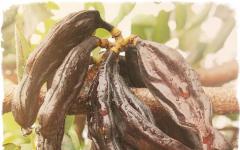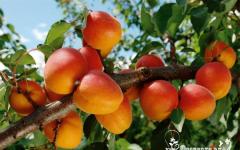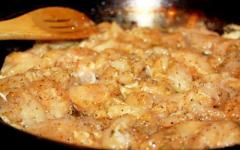In the southern regions of Russia, in almost every yard you can see a green tree covered with yellow-orange fruits, the bones of which are oval-shaped. This is an apricot. Planting and caring for them do not represent work in a warm climate. In the middle lane and in the Urals, more effort is needed for this, but the result is worth it.
Up to 1-2 days it is recommended to moisten well with peat. When you plant in the spring you need about one-third of the reduced shoots - to get better roots. If the plants were grown in pots, there is no need to reduce the shoots, it is necessary to destroy only the rings that appeared in the planting year: flowering and berry binder significantly slow down the growth of shoots and prevent the creation of plants in a new place.
Apricot trees grow very large, so they need a lot of space in the garden. It is true that they are slightly less in cocoa plums. And here they rise in apricots with tall and very wide crowns. In addition, they are rarely limbs, usually cross-breeds. This means that in the garden at least two apricot trees should be grown in different forms. When growing apricots in collective gardens, there are usually no pollination problems: if another apricot grows at a distance of 50 m, it is believed to grow close to it, and the maximum distance between trees can be 200 meters.
Which varieties are better to choose
In areas with a cold climate, you need to plant varieties specifically bred for such weather conditions. Some frost-resistant apricot trees reproduce by self-pollination, therefore, it is advisable to root several species of seedlings with different ripening period in the summer cottage.
- "Kichiginsky". The hybrid tolerates severe frosts and grows rapidly. Fruits in 5 year. The ripe fruit is juicy, fragrant, medium in size, the core of the seed is sweet;
- "Snezhinsky". Feels great in arid and cold climate. The first fruits appear at 4 years after planting. Have a bright yellow color with a red blush on the sides. Sweet pulp quickly moves away from the stone;
- "Piquant". It grows well in central Russia. Variety resistant to frost. Small yellow fruits ripen in early August, are distinguished by juiciness, delicate aroma and spicy bitterness.
In addition to these varieties, Siberian “Amur”, “Khabarovsk”, “Siberian Baikalov”, “Minusinsk amber” and “Seraphim” are successfully grown in Siberia. All of them are adapted to the harsh climate and are recommended by breeders for planting in the northern regions of the country. The main feature of these trees is that their fruits have time to ripen in the short Siberian summer and the taste is no different from the juicy southern apricots.
It is better to grow apricots in the harbor, in a sunny location, on the east or southeast side. It is better not to grow on the south side, because the trees then explode earlier, therefore it is more likely that the buds will suffer from frost. The peach tree is not as big as apricot. Peaches blossom in about a week than apricots, so avoid dangerous frost. Peaches are chosen as the warmest place of the manor, the south side, the harbor, the sun. And peaches and apricots are better planted in the spring and not in the fall.
This avoids at least one winter risk. It is only necessary to pump out the plants early, until the trees are broken - from the first of April to the tenth day. Apricots and peaches are a rather rare plant in our orchards, because they are pretty leprosy and fear by day. However, gardeners have already learned how to grow, some apricot and peach breeds, in those climatic zones where relatively cold holes predominate. Typically, these stones live for several decades, but cold umens shorten your life, and they last up to 20 years.
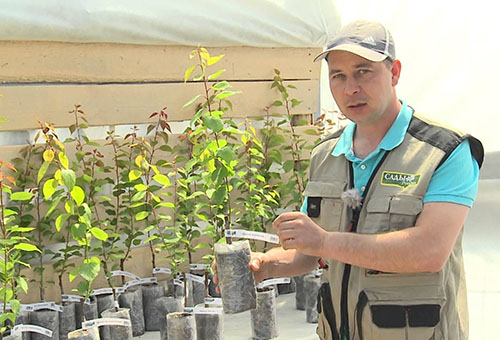
How to choose seedlings
To plant apricot seedlings was successful, you need to choose the right place. The southern tree loves the sun, so prepare a well-lit area on an elevation carefully closed from the draft and the wind. In such conditions, you can quickly get the fruits in the Urals.
Peaches begin to grow fruit within 2-3 years. Apricot is rich in potassium, calcium and other trace elements. Peaches Description Peaches are sprinkled from Asian countries, but are also grown in Europe. Brew from 4 to 10 meters in height. Yuji is rich in pink veins. Fertility is yellowish and pink, more plum and gently cleaned. Like all masons, you usually require you to grow another peach nearby, only then fruit will be gathered.
Yuji early spring spring white. Provides yellow fruits the size of plums, they grow quite close to the branch. Food and processing. Planting and gardening Apricots and peaches have a lot of sunlight, and then they grow much faster. If you have already decided to grow these plants, pick them up at sunset. When planting stone fruits, it is recommended to dig 60 cm depth and 60 cm width of the plots, so that the roots of the plant stick to the bottom and are not bent. Improve the quality of peat and compost yumenov, add some organic matter.
When purchasing seedlings, make sure of their quality. It is better to acquire trees that are one year old, they are well rooted. Carefully inspect the branches. They should not be spines, as this is a sign of only wild varieties. Be sure to check the small spike, which is always formed at the site of vaccination. Pay attention to the root system, if it is frost-bitten or there are signs of rotting on it, do not buy the plant. The chance that it will take root, is zero.
When you plant trees, you need to plant one tree, one bucket of water needed for the tree so that the air accumulates on the surface. It is recommended to feed phosphorus and potassium every three years. When planting, for any tree, it must be tied to the handle so that the tree grows straight and the rope does not feed the chest. Apricots and peaches must be cut and bleached from the body, since bleaching helps to avoid high levels of yellowing caused by the sprayed sun. Apricots and peaches are not so well suited for one, so the dwarf should be the second tree.
Planting tree
The optimal time - planting apricot in the spring. Over the summer, the fragile sapling will get stronger, take root, gain strength. This will help him to calmly survive the cold winter in central Russia.
Apricot is unpretentious to the choice of soil, but it is better to plant it in the fertile, loose earth. Dig it before winter and feed it with mineral and organic fertilizers. An adult tree has a fairly wide crown. He needs a lot of space for normal development and fruiting, so dig holes in the fall at a distance of 5 m from each other. During the winter and spring, the soil will settle in them, and they will be ready for rooting of seedlings. The recess must be such that the root system of the tree is freely placed in it, and there is still little space left. Usually about 80 cm are dug inside and 70 cm wide.
The trees you buy can be self-cut with a non-stick coating. There may be different rocks, but it is important that the stones grow at the same time, because if they are collected at different times, they will not hide each other. Sometimes the branches of peach and apricot are loud because they usually do not dry out, so they need spring springs. The distribution of plants is 5-7%. urea solution - it protects them from harm. To grow fruit and make plants easier to adapt to the climate, most peaches will be smeared with cuckoo cream.
- To protect the roots from stagnant moisture, put a thick layer of drainage at the bottom of the pit. This may be broken brick, gravel or small pebbles.
- Then add 2 buckets of mullein, a half-liter jar of superphosphate, 250 g of wood ash and 350 g of potassium sulfate. Add some ground from the garden and mix the mixture thoroughly. She has to fill the pit by 1/3.
- Put the seedling inside and cover it with soil so that the root neck is 4 cm above the ground level.
- Ram the ground under the tree and make a wide cushion of earth around it. It is necessary that the water does not spread when watering.
At the end, moisten the sapling with 2 buckets of water and tie it to a wooden peg.
And she usually grows a lot of peanuts. These lungs should be drowned. Resistant to bird peaches - “Victor”, “Donetsk bily”, “Dnepr”, “Mayra” and “Velvet”. The red sky, an American breed, has especially juicy, fragrant fruits. Velvet ripened large ounces.
The breed Abrikosh recommended for breeding - "Northern Triumph." The whole breed must be protected from shoots. It is advisable to bleach the stems, the younger stems should be covered with fir branches or ribbons. Cover the roots with portable medical supplies.

How to care
Growing apricots in cold climates has some peculiarities. Take care of him all year round. When snow falls, the root neck needs to be cleared of it, so that the ground near the trunk is frozen. It does not hurt the tree.
Cherry is a perennial plant that grows up to 7 meters in height. It grows in the form of honey or bark, according to which species and types are distinguished. Cherry cherry type is more durable and more compatible. The outputs of the cherry are different, depending on the right conditions and the place of their growth. The most suitable yarrow for cherry, which is wide, easily absorbs water and is not too harsh. Usually healthy and adult flowers give up to 40 kg of berries. Your fruits are large, good taste, suitable for cooking and cooking.
The cherry tree belongs to the tribal family of the Kabul family. Cherry buds are common or vegetative. Yuajiya forms yuda and ripe berries, as well as vegetable leaves and horseradish. In order for the cherries to give berries, they need to plant them on two krill, because most breeders are not cut down, so they need a pair. Before planting cherries, it is necessary to prepare well and get suitable quality trees. The roots of the cherry tree must be rooted, and the branches are proportionally divided on both sides of the trunk.
During the period of melting snow comes a dangerous time for apricot. A large amount of water fills the root neck. Night frosts freeze the water again, and the neck starts to scream. Such a phenomenon is a frequent cause of the death of apricots in the Sverdlovsk, Chelyabinsk regions and in Siberia. To avoid this, in the spring, be sure to scoop the snow away from the trunk, dig small grooves for draining water and carefully mulch the soil.
Yum needs to grow and maintain so that the tree has enough material to grow. Before planting cherries need to get a hole with the proper depth. The roots of the medium should not be collapsed, and the depth is such that you can see the substrate a little. Pour out the brooms, pour out a bucket of water to make the air fall out of the yellow. Hold the medallion in the chest to grow vertically. If there are rabbits or other wildlife in the garden that are trying to smell more young fruit trees, surround the chest with a protective net.
Autumn stems need to be blown off, because you will protect the sun from the disorder, which, in particular, creates large juvenile strains. Cherry seed, like most mediums, begins in spring. Cherry is formed by straw. In the first year, new ones are cut off. If we thicken a wreath more often, branches that are older than three years are reduced. Make sure you don’t put many ghosts on one tension, because you can cry out of it. Pamper the garden with grease. The third breeding begins with the berries or immediately after you.
When it gets warmer and the tree blossoms, it needs regular moderate watering. Moisten it once every two weeks, using 5-6 buckets of water, but make sure that it does not stagnate in the root system. A few days after watering gently loosen the ground under a tree and systematically get rid of weeds.
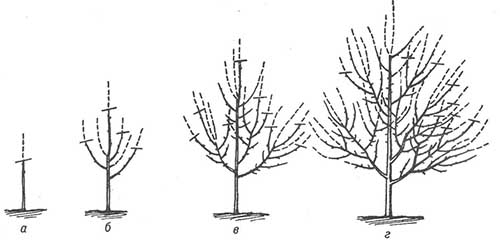
Crispy cherry is more resistant to halibut and more compatible, and its fruits are sweeter and longer. The first fruits often give 4-5 years after planting. Whether there is a shortage of food in the soil, it can be identified from cherries and common fruit trees. If nitrogen is poorly developed, the rock leaves glow. When phosphorus is insufficient, the leaves become purple hues. And if potassium comes out, it will be pink in the foothills underfoot. Currently, you can buy a lot of cherries and cherries for other gardeners.
Cherries are multiplied by roots of roots, roots of cuttings, grafts, and juvenile cuttings. Gardeners are the most affordable way for bastards to replenish charming atol. The root can only be taken from the selected valuable properties of the cherries containing the plant. You need to make sure that they really grew from the root of the selected cherry. A suitable recipe for the breed grew out of a horizontal root, and the sage root grew out of a grid, small, vertical.
Pruning
If you prune correctly, the tree bears fruit better and becomes more frost-resistant. When buds bloom, the branches that grow inside the crown and thicken it, clean. This stimulates the growth of young twigs, which in a year or two will fasten fruit. Experienced gardeners are advised to form a tree on a sparsely-tiered type, when the shoots grow at a distance of 35 cm from each other. Old branches that are not tied to the fruits, it is recommended to remove.
Cherry is delicious, refreshing and ideal for processing. It produces granules, compotes, juices. Cherries are very used for pickling and tanning as spices. Cherries are important for people in a rational diet because they contain enough vitamins and organic raisins. Cherry can be cleaned and used for tea, because it is well known for its cuisine.
Cherry is used only in traditional medicine. It improves appetite and improves the processes of hoarseness and decay in uran. It is also used to treat respiratory problems. Cherry-bones are poisonous, so you can not eat. Even a jar should be consumed throughout the year, because if the jam contains cinnamon pips, cyano-saws can appear from the bone in a year.
For apricot thaw is dangerous in the winter. From her tree, young buds instantly awaken. When the air temperature drops again, they freeze and die. Apricot starts to grow poorly and does not bear fruit. To avoid this, experts advise all young shoots to pinch their tips in June. This procedure prevents them from waking up during thaws in the winter.
Spring is the time of planting stone fruits. Only at first glance it seems that this is a plant that is absent, but in fact it is a very capricious and demanding tree. Negligent plums contain almost all B vitamins, which strengthen the nervous system, reduce fatigue and insomnia, improve mood. Their vitamin K improves blood composition, reduces blood clots, and vitamin P strengthens arterial and capillary walls.
Plants to choose from - sunny, protected from winds and spring frosts. The most suitable soil is moderate clay, conducting water, neutral reactions. It is very important that the groundwater is not more than 1, 5 meters from the ground. One of the most common problems due to which plums do not work well is that it cools down and is not suitable for soil or planting. They do not like plum and drought, so they should not be planted next to large trees, and water is required throughout the season.
Council Do not forget to do sanitary pruning of wood. Get rid of sick and drying shoots in time.
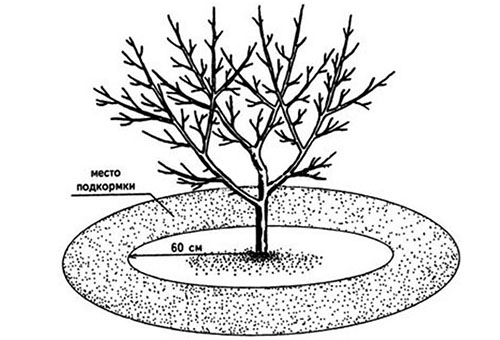
How to apply fertilizer
Growing apricots in central Russia requires timely feeding. If during planting a sufficient amount of mineral substances have been added, start fertilizing the soil for the next year.
Cultivated plum varieties grafted onto Caucasian plums or Wanginheim ivy varieties are most common in Lithuania. They are grafted into a Caucasian plum rather high in height, they tend to shoot the root, but are more resistant to frost and disease.
You have nothing to say about the features of planting, because they are almost the same for all fruit trees. It is better to plant the plumage in spring, leaving the outcrop until the buds are still tired. The grafting site should be on the ground or a few centimeters below the ground. We plant a planted tree abundantly, then we mulch it. Mulch should be at least 2-3 years old, about 1 meter around the trunk. In the year of planting it is better not to fertilize the fruit. Young, strong, but inappropriate trees are better not to fertilize.
- In the spring of 2-year-old tree is useful to feed the infusion of fresh chicken manure. For its preparation, a litter bucket is diluted with water in a 15 liter barrel. Let it brew for several days, and add 10 liters of liquid under each barrel. Instead of organic matter, you can use purchased nitrogenous fertilizer according to the instructions.
- Before flowering in 10 liters of water, dilute 1 tbsp. l potassium sulfate, 2 tbsp. l ammonium nitrate and poured with nutrient liquid apricot. This feeding is repeated after flowering.
- In autumn, the area where trees grow is dug up and fertilized with compost or rotted manure.
The older the plant becomes, the more fertilizer it needs. At 4 years of life, the number of ingredients should be increased by 2 times, by 8 years, when it is already actively bearing fruits, by 3 times, and so on.
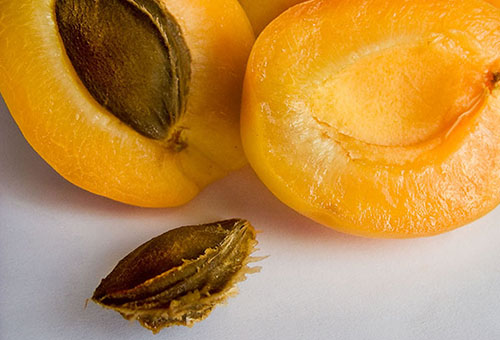
How to grow apricot yourself
In central Russia and in the Urals regions, many gardeners prefer to grow apricot from the stone. This seedling adapts better to the climate, less sick and more fruitful.
In the summer, the stones are harvested from large ripe fruits, thoroughly washed, dried and stored in a canvas bag at room temperature all winter. In order for the seeds to take root, you need to know how to plant an apricot in the spring.
- In early March for a week be sure to soak the seeds in cold water, which is replaced daily with a new one.
- Then mix in equal quantities moss, sawdust and sand, moisten them and place them together with the apricot seeds in a plastic bag. Planting material should take 1 part of the prepared substrate.
- Make small holes in the polyethylene for air circulation and store the bag at about 4-10 C.
- After one and a half or two months, check the seeds. They should crack and germinate. In some varieties, this happens quickly; in others, germination must be waited for several months.
In early May, the bones are planted in open ground, pre-digging and fertilizing the ground. On the site, dig holes in the 20 cm from each other at a depth of about 10 cm, put the bones there, covered with earth and watered. At the end of the bed mulch peat. The sprout quickly splashes out of the ground, buds appear on it, and over the summer it stretches up to 100 cm. It can be transplanted next year.
In the northern latitudes, some summer residents do not transplant a tree grown from a stone. At the same time, its varietal qualities change, but the plant tolerates strong frosts better.
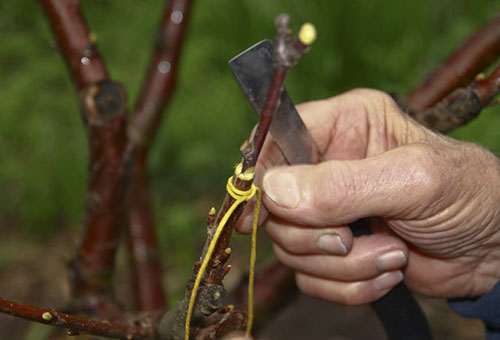
Graft
Apricot is often propagated by grafting. To do this, pick up a young stock and get an apricot stalk that bears fruit well. This is done in the spring, when the movement of the juice begins and the kidneys awaken. The procedure is quite complicated, so experienced gardeners resort to it.
Every year the number of apricot trees planted in the server regions of Russia increases. Gardeners enthusiasts are not afraid of the vagaries of nature, and they manage to get a big harvest. If your cottage does not have apricot yet, be sure to purchase a frost-resistant sapling or grow a tree from a stone. With proper care, it will quickly thank you with sweet fruits.
- reduce the body's immune defense
- drowsiness
- frequent fatigue
- depressed
- headaches, as well as various pains and cramps in the internal organs
If you feel frequent ailments, you just need to clean the body. How to do it
Apricot is an early flowering beautiful tree, it is a tasty fruit, it is vitamins and trace elements. Fresh apricots are completely harmless to everyone, even for those who are overweight. Therefore, every gardener wants to have this tree on his site.
Purchase of apricot seedlings
The best planting material is a well-developed seedling of the first year.
These seedlings take root better, more convenient for the formation of the crown.
It is necessary to acquire seedlings in specialized stores or nurseries; if you purchase a seedling of accidental origin, you can get a seedling (Zherdel) instead of apricot.
Cultivar seedlings do not have thorns, annual branches of apricot seedlings are thick, they must have spines (stumps from the cut trunk of the stock above the cultural bud) at the base of the inoculation.
Seedlings with a dried root or with a frozen overground system do not take root.
Planting apricot
The best time to plant an apricot is early spring.
At the same time, if the spring is rainy, it provides excellent survival of the seedling. Wearing sports sweatshirts, we plant seedlings in pre-cooked pits, which are prepared in autumn, measuring 80x80x80 cm.
2-3 buckets of humus or ripened compost, 500 grams of superphosphate, 2 kilograms of ash are brought into the pit, all this is thoroughly mixed, 1/3 of the depth is filled with a pit by this soil mixture, a hillock is made from the soil mixture in the center of the pit so that on the seed stock, the root neck was 5-6 cm below the edges of the pit for chernozem and 10-12 cm for sandy soils
In plants grafted on clonal rootstocks, the grafting site is placed at the level of a hill.
Before planting, the roots of an apricot seedling are dipped in a soil talker.
Having installed the plant on a hillock, the roots are filled with the mixture prepared in advance, the top layer of the filling is made with soil from the lower layers of the dug hole, the soil is compacted, an earthen roller up to 10 cm high is made around the landing pit so that the water does not spread during irrigation.
It is better to plant three plants of different ripening periods on the site, the need for such an amount is due to the fact that most apricot varieties are partially self-bearing and do not produce high yields without cross-pollination of flowers with pollen from other varieties.
After planting, the seedlings are watered with 2-3 buckets of water, the settled soil is filled to the previous level.
Apricot pruning
Planted annuals are cut at a height of 30 cm from the soil surface. From the remaining buds on the stem, lateral spring shoots develop and the stem continues to escape.
a) pruning after planting, b) in the spring of the second year, c) in the spring of the third year, d) in the spring of the fourth year
Apricot Care Rules
In the first two years after planting the seedling, the pristvolny circle of apricots is contained in a loose, clean from weeds or under organic mulch. If there is good watering, the soil can be kept under the sap of cereal perennial grasses, when the grass grows to 20-25 cm, it is trimmed.
If the trunk circle is kept in a loose state, the depth of loosening under the crown should not exceed 6–8 cm to prevent injury and cutting of the roots.
Before fruiting, organic and phosphate-potassium fertilizers can be avoided; nitrogen fertilizers should be applied annually at 20-30 grams per square meter in two terms: in spring and after harvest in half doses.
After the apricot starts fruiting, it is necessary to add 30 grams of ammonium nitrate, 8 grams of superphosphate, 20 grams of potassium salt per square meter of tree trunks annually.
Organic fertilizers are applied once every 3-4 years, if apricots grow under sabotage, organic fertilizers are not applied.
Apricot responds well to nitrogen fertilizers, but their excess reduces the resistance of plants to disease, causes gum treatment, delays fruit ripening, and leads to superlong growth (more than 100 cm).
On heavy and acidic soils, apricot reacts positively to the addition of calcium. It is better to apply fertilizer in the liquid state, in a dry form it is introduced into the grooves or into the wells before irrigation.
During the period of hardening of the seed, the active growth of fruits and shoots, apricot requires abundant watering.
Overloading trees with fruits leads to their weakening and poor fruit set in the next year. Therefore, it is necessary to carry out annual spring pruning of trees, besides manual manual thinning of fruits after shedding the ovary is recommended.
The correct ratio between the number of fruits and leaves in apricot 1:20.
Before manual thinning, the tree is shaken so that the underdeveloped, diseased and damaged fruits fall, then remove the defective, poorly located and crowded fruits.
It is necessary to observe phyto-sanitary hygiene:
- remove all diseased branches and shoots, burn them;
- clean the wounds, make them disinfected and putty;
- to collect and burn carrion and diseased fruits;
- collection and burning of diseased leaves;
- annual disinfection of wood with a solution of lime (in autumn or early spring);
- annual binding of the central conductor and the base of the skeletal branches with thick paper or other material to protect the plant from sunburn and rodents in the winter.
Apricot annual pruning
With good quality planting material and good care, spring is growing rapidly and summer shoots appear. This property must be used during the period of formation and fruiting of the plant, for which spring acute-angle shoots pinch over 2-3 leaf, shoots selected as skeletal, pinch over the fifth leaf.
In the summer (July), the shoots, which form the skeletal branches, pinch at a length of 30 cm. At the same time, the shoots continue the stem.
The following year, in the spring annual growths are subjected to spring pruning.
On skeletal, semi-skeletal branches and the central conductor, they are shortened by 1/3 of their length, and weak annual gains of other branches are shortened by 1/3 to 1/4 of their length.
Further, the spring shoots that have appeared are subjected to summer pruning, 20-30 days after the spring by 1/2 of their length during regrowth more than 40 cm, and shoots up to 15 cm long pinch over a normally developed leaf.
Apricot, mainly fruits on annual branches of different lengths, as well as on special fruit-bearing formations - spur and bouquet branches.
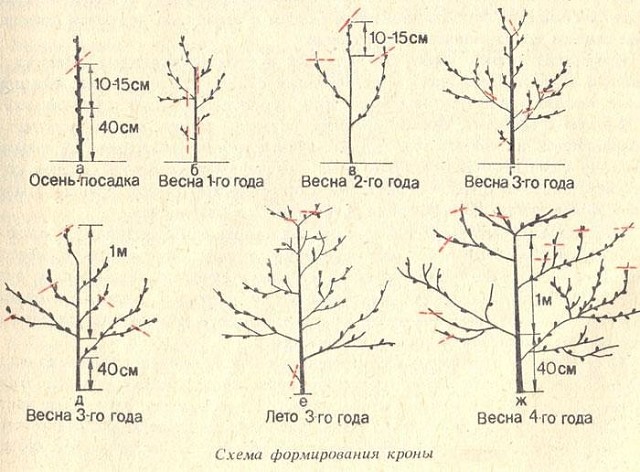
The main task of pruning apricot trees is to ensure the annual formation of new, fairly strong shoots.
On elongated shoots, compared with short, fruit buds are laid later, late buds tolerate provocative warming better in winter.
For 2-3 years of the tree's life, the moderate shortening of the main branches and the central conductor continue, subject to the rules of subordination of branches in the crown.
The degree of pruning increase in weakly branching varieties and vice versa, reduce with strong-medium branching.
After the transition of the tree to fruiting, shortening is weakened, and with strong branching, temporarily suspend and increase the thinning.
Pruning, normalizing fruiting, increases the resistance of trees to low temperatures.
In addition, apricot trees, like a landing site, where there are no winds.



